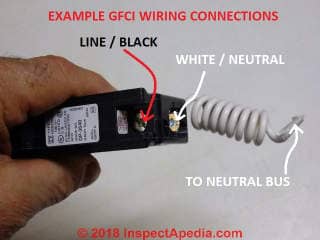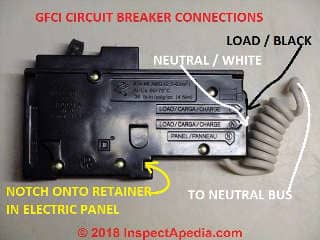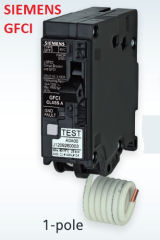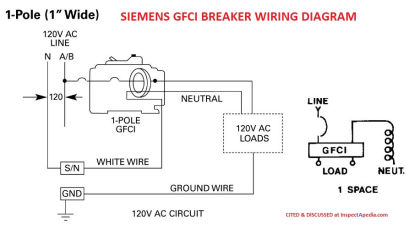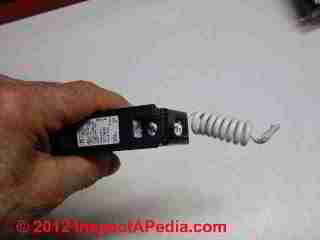 Arc Fault Circuit Interrupter AFCI Installation, Testing, Recalls
Arc Fault Circuit Interrupter AFCI Installation, Testing, Recalls
How to wire-up & test a residential-use AFCI, AFCI recalls
- POST a QUESTION or COMMENT about buying, wiring, installing, & using AFCIs and the performance and about possible nuisance tripping of arc fault circuit interrupters
Arc Fault Circuit Interrupter Installation, Wiring, Testing, Recalls:
This article describes how to install AFCIs & how to test AFCIs. We also explain the difference between an arc fault circuit interrupter (AFCI) and a ground fault circuit interrupter. The article also describes AFCI Recall in 2004 & provides a Square-D & Federal Pioneer AFCI Notice. Here are tips for wiring & using AFCI's for arc fault protection to help reduce fire risk in homes.
This article series, adapted and expanded from a US CPSC article on AFCIs is supplemented with additional details and commentary answers most home owner and home inspector questions about installing, testing, and inspecting AFCIs - arc fault protectors in homes.
InspectAPedia tolerates no conflicts of interest. We have no relationship with advertisers, products, or services discussed at this website.
How to Install an Arc Fault Circuit Interrupter (AFCI)
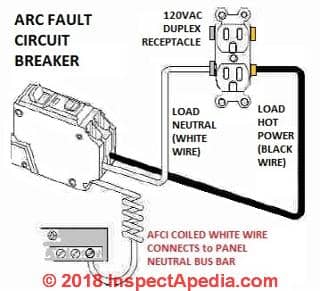 AFCI circuit breakers should be installed by a qualified electrician. The installer should
follow the instructions accompanying the device and the panel box.
AFCI circuit breakers should be installed by a qualified electrician. The installer should
follow the instructions accompanying the device and the panel box.
In homes equipped with conventional circuit breakers rather than fuses, an AFCI circuit breaker may be installed in the panel box in place of the conventional circuit breaker to add arc protection to a branch circuit.
[Click to enlarge any image]
The AFCI installation wiring diagram shown here and others are available from GE, General Electric Corporation and GE circuit breaker distributors.
Homes with fuses are limited to receptacle or portable-type AFCIs, which are expected to be available in the near future, or AFCI circuit breakers can be added in separate panel boxes next to the fuse panel box.
An AFCI hookup wiring diagrams and detailed instructions from GE is available in
these GE AFCI INSTALLATION INSTRUCTIONS. Other manufacturer's Arc Fault Interrupter installation guidelines will be similar.
Safety Warning: Do not attempt to work on your electrical wiring, switches, or outlets unless you are properly trained and equipped to do so. Electrical components in a building can easily cause an electrical shock, burn, or even death.
Even when a hot line switch is off, one terminal on the switch is still connected to the power source. Before doing any work on the switch, the power source must be turned off by setting a circuit breaker to OFF or removing a fuse.
See SAFETY for ELECTRICAL INSPECTORS and also see
these ELECTRICAL WIRING BOOKS & GUIDES
Three Wire Connections on a Typical AFCI Circuit Breaker
Typically for an electrical circuit to be protected by AFCI, in the electrical panel the circuit hot and neutral wires are connected to marked terminals on the AFCI circuit breaker and a third wire connects the AFCI breaker to the neutral bus in the electrical panel.
You can see my connections in the process of installing an AFCI in the photograph. (Your AFCI device terminals may differ but will be marked)
- Load power wire (black) connects to the upper screw marked on this AFCI.
- Load neutral wire (white) connects to the center scfrew on this model AFCI.
- Coiled white wire that is factory-connected to this AFCI is connected from the AFCI to the neutral bus in the electrical panel.
[Click to enlarge any image]
An AFCI circuit breaker, because it is monitoring the neutral wire in the circuit as well a the hot wire, will have three wires connected to it even if it's just a 120Volt single pole breaker. Follow the installation wiring details given by the manufacturer.
Our photos show a Square-D AFCI on which the wire connections are also embossed into the circuit breaker's molded case.
On these special circuit breakers you will see
- the circuit hot wire, normally black, occasionally red, typically as the second hot wire on a 240V circuit breaker or on a multi wire branch circuit sharing a common neutral wire.
See details at MULTI-WIRE CIRCUITS - the circuit white wire, the neutral wire for the circuit
- a third white wire that is permanently connected to the AFCI breaker and whose other end is to be wired to the neutral bus in the electrical panel to complete the neutral wire part of the circuit that now passes through the AFCI breaker.
Usually this third wire is a multi-strand coiled wire like the one in my photo.
In sum, to install this AFCI you will need to properly connect all three wires: the circuit hot and neutral wires are are connected to screw terminals on the circuit breaker.
The third white wire that is permanently connected to the circuit breaker and whose other end connects to a screw terminal on the neutral bus in the electrical panel.
AFCI Arc Fault Circuit Interrupter Manufacturers & Installation Instructions
Above Siemens single pole GFCI circuit breaker and wiring diagram. Instructions and contact information are given below.
- AFCI GFCI WIRING, TESTING & SAFETY - separate article contains more links to PDFs of instructions for wiring Ground Fault Circuit Interrupters, GFCIs
- Eaton, INSTALLING A COMBINATION AFCI / GFCI CIRCUIT BREAKER [PDF] (2011) Important Safety Instructions for Installing Circuit Breaker Branch/Feeder 120/240 2-Pole Arc Fault Circuit Interrupter (AFCI) and Ground Fault Circuit Interrupter (GFCI), Eaton Cutler Hammer, Eaton Corporation Electrical Sector 1111 Superior Ave.Cleveland, OH 44114 United States 877-ETN-CARE (877-386-2273) Eaton.com retrieved 2020/11/22 original source: http://m.eaton.com/ecm/groups/public/ @pub/@electrical/documents/content/pub-49748.pdf
Excerpts: What is an Arc Fault Breaker and GFCI?It is a new type of circuit breaker with additional circuit protection, which mitigates the effects of an arcing fault, and also provides personnel ground fault protection.
a. Connect the coiled white “pigtail” wire from the circuit breaker to the panel or enclosure neutral bus terminal & secure tightly.
b. Connect the white (neutral) load wire to the terminal side of the circuit breaker identified with a white mark.
c. Connect the black (hot) load wire to a circuit breaker terminal marked “LOAD”.
d. Connect the red (hot) load wire to the other circuit breaker terminal marked “LOAD”. - Eaton, INSTALLING & TESTING AN OUITLET BRNCH CIRCUIT AFCI [PDF] retrieved 2021/09/21 original source: https://www.eaton.com/content/ dam/eaton/products/ wiring-devices-and-connectivity/wiring-devices/afci-receptacles/afci-instruction-sheet.pdf
- Eaton Cutler-Hammer ARC FAULT CIRCUIT INTERRUPTER AFCI INSTALLATION INSTRUCTIONS [PDF] (2003), Eaton Cutler Hammer, 1000 Cherrington Parkway, Moon Township PA 15108 USA (Rev 4) retrieved 2019/02/08
- Eaton Cutler-Hammer ARC FAULT CIRCUIT INTERRUPTER Type BR (1") Combination Single Pole Breaker INSTRUCTIONS [PDF] (2012) retrieved 2019/02/08
- Eaton Cutler-Hammer ARC FAULT CIRCUIT INTERRUPTER Type CH (3/4") Circuit Breaker INSTRUCTIONS [PDF] (2014) retrieved 2019/02/08 original source: http://www.eaton.eu/ecm/groups/public/@pub/@electrical/documents/content/td003006en.pdf
- Eaton Cutler-Hammer Arc-Fault Interrupters FAQs [PDF] (2009) retrieved 2019/02/08 original source: http://www.eaton.com/ecm/groups/public/@pub/@electrical/documents/content/ct_206788.pdf
- GE, ARC-FAULT CIRCUIT BREAKER INSTALLER INSTRUCTIONS [PDF] (2002) General Electric Company41 Woodford Ave., Plainville, CT 06062 USA
Excerpts:
This circuit breaker is intended for use on single-phase grounded, 120 Vac 2-wire branch circuits.
Use only cable having two conductors plus ground,such as NM-B cable.
Do NOT use cable having three conductors plusground.
Do not use the breaker on a shared-neutral circuit.
- General Electric COMBINATION AFCI APPLICATION GUIDE: SHARED NEUTRAL CIRCUITS [PDF] (2009) retrieved 2019/02/08
Excerpt:
Until now, using a shared neutral (multiwire branch circuits) on arc fault protection circuits required the use of 2-pole AFCI breakers, since the AFCI circuitry uses a ground fault CT to help it detect arcs.
But with GE’s newly developed combination AFCI technology, no ground fault CT is required, so shared neutral circuits can be used with two 1-pole AFCIs connected together with a handle tie... - General Electric DEH-40456 ARC-FAULT CIRCUIT BREAKER TWO-POLE INSTALLATION INSTRUCTIONS [PDF] (2001) Type THQL-AF and :THHQL-AF retrieved 2019/02/08
- General Electric DEH41543 COMBINATION ARC FAULT CIRCUIT BREAKER INSTALLATION INSTRUCTIONS [PDF] (2011), General Electric Co., retrieved 2019/02/08 original source: http://apps.geindustrial.com/publibrary/checkout/DEH-41543?TNR=Installation%20and%20Instruction%7CDEH-41543%7Cgeneric
- General Electric GEH-41542 ARC FAULT CIRCUIT INTERRUPTER (AFCI) INSTALLATION INSTRUCTIONS [PDF] (2015) General Electric (GE), 41 Woodford Avenue Plainville, CT 06062 USA, www.geindustrial.com Tel: 1-800-782-8061. retrieved 2019/02/08, original source: http://apps.geindustrial.com/publibrary/checkout/GEH-41543?TNR=Installation%20and%20Instruction%7CGEH-41543%7CPDF&filename=GEH-41543.pdf
- Legrand AFCI/GFCI RECEPTACLE INSTALLATION & TESTING INSTRUCTIONS [PDF] retrieved 2019/02/08, original source: https://www.legrand.us/~/.../installation-instructions/radiant%20afci_gfci-english.ashx
- Leviton AFCI RECEPTACLE INSTALLATION INSTRUCTIONS [PDF] retrieved 2019/02/08, original source: https://www.leviton.com/es/docs/AFCI_Instruction_Sheet.pdf
- Lutron Electronics, AFCI-INSTALLATION FAQs [PDF] (2018) Lutron Electronics Co., Inc.
7200 Suter Road
Coopersburg, PA 18036-1299
TEL: +1.610.282.3800
FAX: +1.610.282.1243
support@lutron.com
www.lutron.com/support
North & South America [Lutron also has offices in the UK, Singapore and Asia) retrieved 2019/02/08 original source: http://www.lutron.com/TechnicalDocumentLibrary/AFCI_FAQ.pdf
Excerpt:
This document will cover the basics of an Arc-Fault Circuit Interrupter (AFCI) and will discuss the specific models of breakers that can control a full circuit of dimmed lighting. As of January 2010, the Square DR AFCI breakers used in Lutron HomeWorks QS AFCI dimming panels are able to control 2000 W (16 A) of connected dimming load without any false tripping.
Eaton also offers AFCI breakers that are rated for use in EatonR load centers and can control 2000 W (16 A) of connected dimming load without any false tripping. - Schneider Electric Schneider QO/QOB AFCI ARC FAULT CIRCUIT INTERRUPTER INSTALLATION INSTRUCTIONS [PDF] (2020) Schneider Electric, retrieved 2021/09/21 original source: https://download.schneider-electric.com/ files?p_enDocType=Instruction+sheet&p_File_Name= 48840-123-04.pdf&p_Doc_Ref=48840-123-04
in English, Spanish, French
Schneider Electric Canada, Inc. 5985 McLaughlin Road Mississauga, ON L5R 1B8 Canada 800-565-6699 www.schneider-electric.ca
Schneider Electric USA, Inc. 800 Federal Street Andover, MA 01810 USA 888-778-2733 www.schneider-electric.us
Schneider Electric México, S.A. de C.V. Av. Ejercito Nacional No. 904 Col. Palmas, Polanco 11560 México, D.F. 55-5804-5000 www.schneider-electric.com.mx - Schneider Electric SQUARE-D HOMELINE COMINATION AFCI (CAFI) INSTALLATION INSTRUCTIONS [PDF] (2020) for the Square D Homeline and Combination Arc Fault Interrupter CAFI 48840-249-01
- Siemens AFCI ARC FAULT INTERRUPTER INSTALLATION INSTRUCTIONS [PDF] (2010) Siemens Industry Inc., NOrcross GA, retrieved 2019/02/08, original source: https://www.downloads.siemens.com/download-center/Download.aspx?pos=download&fct=getasset&id1=BTLV_40624
How to Test an Arc Fault Circuit Interrupter (AFCI)
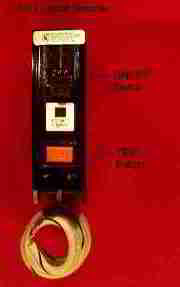 Using the test button on an AFCI
Using the test button on an AFCI
AFCIs should be tested after installation to make sure they are working properly and protecting the circuit.
Subsequently, AFCIs should be tested once a month to make sure they are working properly and providing protection from fires initiated by arcing faults.
A test button is located on the front of the device. The user should follow the instructions accompanying the device. If the device does not trip when tested, the AFCI is defective and should be replaced.
InspectAPedia Notes: How the AFCI Test Button Functions
Because it has been misunderstood and criticized it's worth noting that the test button on an AFCI does not simply force the mechanical internal switch of the AFCI to trip.
Rather, the test button on an AFCI tests the arc fault detection circuitry to be sure that it is working properly, that it will respond to an arc fault, and that the circuitry will in turn cause the mechanical internal switch to open.
This is an important distinction to remember, since the Ground Fault Circuit Interrupter (GFCI) has faced similar criticism. We've certainly found lots of GFCI's which exhibited an error when the GFCI test button was pressed: the button caused the GFCI to trip but the device was defective or improperly wired so that it would not protect the circuit.
Using AFCI indicator tools vs AFCI "test tools" - AFCI Indicators is not recommended
As of September 2008 we have found no test tool that reliably and completely tests the function of an AFCI. Only the integral test button tests the circuitry of the device as well as the trip mechanism. UL classes these "test" devices not as "testers", but as "indicators".
A problem is that some devices used to "inspect" an AFCI, in trying to produce a simulated arc fault condition, may fail to cause the AFCI device to trip even though it is perfectly fine.
Literature from the manufacturer of a popular "test tool" tells the user of the tool to go to the electric panel and use the test button on the AFCI device to make sure it trips. In other words the inspector cannot rely on the separate test tool. For this reason you will see such tools referred to as "indicators" rather than "testers": they are not a complete and reliable test instrument for AFCIs. -- Mike Holt
See important safety and electrical procedure details
at AFCI GFCI WIRING, TESTING & SAFETY
AFCIs vs. GFCIs: What is the difference between an Arc Fault Circuit Interrupter and a Ground Fault Circuit Interrupter?
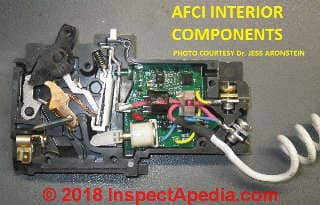 What is the difference between an AFCI Arc Fault Circuit Interrupter and a GFCI Ground Fault Circuit Interrupter? The AFCI should not be confused with the GFCI or ground fault circuit interrupter.
What is the difference between an AFCI Arc Fault Circuit Interrupter and a GFCI Ground Fault Circuit Interrupter? The AFCI should not be confused with the GFCI or ground fault circuit interrupter.
An AFCI is a device intended to prevent a fire. It detects a type of arcing in the electrical circuit that can lead to overheating and a fire.
An AFCI can protect against some types of shock by detecting a short circuit if the short is also affecting an individual, but it is not designed as a shock protector and will not detect all of the same faults as a GFCI.
Photo: a view of the interior components of an AFCI circuit breaker, courtesy Dr. Jess Aronstein.
[Click to enlarge any image]
A GFCI is a device intended to prevent electrical shock. A GFCI will not necessarily detect the type of electrical arcing that can cause a fire.
The GFCI is designed to protect people from severe or fatal electric shocks while the AFCI protects against fires caused by arcing faults. The GFCI also can protect against some electrical fires by detecting arcing and other faults to ground but cannot detect hazardous across-the-line arcing faults that can cause fires.
A ground fault is an unintentional electric path diverting current to ground. Ground faults occur when current leaks from a circuit.
How the current leaks is very important. If a person’s body provides a path to ground for this leakage, the person could be injured, burned, severely shocked, or electrocuted.
The National Electrical Code requires GFCI protection for receptacles located outdoors, in bathrooms, garages, kitchens, crawl spaces and unfinished basements; and at certain locations such as near swimming pools.
A combination AFCI and GFCI can be used to satisfy the NEC requirement for GFCI protection only if specifically marked as a combination device.
InspectAPedia Note: don't confuse this "combination" with the "Combination AFCI described earlier in this article.
While we're discussing the 2008 electrical code changes for AFCI's let's also update ourselves about GFCI's:
How to Report an AFCI or other Electrical or Product Failures or Incidents to the U.S. CPSC
Dangerous Product Reports to the US CPSC: To report a dangerous product or a product-related injury,
call CPSC's hotline at (800) 638-2772 or CPSC's teletypewriter at (800) 638-8270,
or visit CPSC's web site at SaferProducts.gov.
Or use this link https://www.saferproducts.gov/IncidentReporting to report an unsafe product or circuit breaker failure incident to the US CPSC
You can also send the CPSC email on incidents to: info@cpsc.gov
Contact InspectApedia.com: To comment on or suggest additions to this article use the COMMENTS BOX found at the bottom of this page or use our email found at CONTACT
Reader Comments, Questions & Answers About The Article Above
Below you will find questions and answers previously posted on this page at its page bottom reader comment box.
Reader Q&A - also see RECOMMENDED ARTICLES & FAQs
Question: can AFCI's be used in place of GFCI's and vice versa?
(Aug 10, 2015) M Schultz said:
Can GFCIs be used instead of a AFCI?
Can AFCIs replace GFCI?
Why not just have all AFCI breakers or all GFCI plugs?
Reply: no
No M.S.
These devices provide quite different safety protections and cannot be substituted for one another.
GFCI's detect a fault or short from hot to neutral or ground.
AFCI's detect arcing in the electrical receptacle.
I pose that the reason that there is not a combined device in widespread use is cost.
Question: AFCI vs grandfathering homes older than 2008
This does not address grandfathering for homes older than 2008! - John, 7/24/2011
Reply:
Granfathering and the AFCI requirement: good point, John. We find a variety of opinions among building code officials. At a recent building addition project the BCO wanted AFCIs in the new sub panel in keeping with the new electrical code AFCI recommendations, but he also decided that other areas in the home needed certain updates too.
Other electrical inspectors and building code inspectors look only at the new work - I'd say that's the most common case. Only when an older home is being renovated to include electrical work will most inspectors call for current codes to be complied-with.
A more subtle exception occurs in the case of egregious electrical hazards: when an older home is being purchased, some lenders and some insurance companies may require certain updates such as in panel ampacity or in replacement of some of the more troublesome brands (FPE Stab-Lok is an example.)
Question: are AFCI's required on lighting-only circuits?
do you have to use arc fault on lighting only circuits? - Hugh Owen 8/22/2011
Reply:
Yes. On the illustrations I've seen the overhead lighting circuits were included. see 210.12(B) Dwelling Units - quoting the Minnesota Electrical Association reference found at the bottom of this article:
Combination-type AFCI-protective devices are now required in all dwelling unit rooms, except for kitchens, bathroom, garages, basements, and rooms or areas not specified in this section. This continues the incremental migration to provide whole-house AFCI protection for dwelling units that was the objective of the original proposals in the 1999 NEC development cycle.
This section was revised to include a list of rooms and areas where the serving branch circuits are to be protected by arc-fault circuit-interrupter protection.
Essentially, the requirements for this protection are expanded to most areas and rooms in the dwelling unit with the exception of those named above and other areas or rooms not specifically identified in this section. The AFCI-protective devices must be listed combination types.
Question:
I don't have space in the panel to make proper ground bus connections. - Roger 9/11/11
Reply:
Roger, as long as your panel won't be overcrowded, you can always add an additional ground bar (or neutral bar) in the existing panel, connecting it to the originals and locating it where your AFCI white wire will reach.
Question:
I have a Sylvania main breaker panel in an existing dwelling. I am adding 3 circuits to basement finish.
Inspector wants a Listed product for the panel . Any idea what AFCI breaker I can use? - Nice Article 12/10/11
Reply:
Nice:
Any AFCI breaker sold at any electrical supplier will be code compliant. Just how well the product works is a different issue as discussed in this article. Be sure to see the comments and links to Dr. Engel's paper given in FAQs. below.
Question: having trouble wiring 14-3 wired homes
How to deal with 14-3 wired rooms. I need AFCI for the outlets and the lighting, I have wired 14-3 and would need a special AFCI that doesn't seem to be offered by Square D. - Eric J 5/22/2012
Reply:
Erick J
You raise an important question: how to use AFCIs or GFCI's on 3-wire circuits. I don't know a solution and so far the solution certainly is not offered in the device itself. We have ongoing reports as well as direct experience with nuisance tripping and so unreliable behavior when AFCIs or GFCI's are installed on shared-neutral circuits.
The electrician I worked with most recently says he's changed is policy and won't install 3-wire shared neutral circuits where an AFCI or GFCI is going to be required.
In sum, AFCI's are NOT going to work properly on shared-neutral electrical circuits; neither do GFCIs.
Question: Nuisance Tripping of AFCI devices on circuit used to power a TV
I have two Seimen's AFCIs for 3 bedrooms. They were placed approx spring 2004 in a new build. No problems until several months ago with LED TV in master bedroom. Breaker would trip upon trying to turn on tv on rare occasion. At first seemed overload but now it trips every time TV is turned on.
TV is tripping the other AFCI in the other bedrooms as well. It IS NOT tripping the standard breakers elsewhere in the house. Are these older model AFCIs needing replaced to handle the load of the new appliances? Have new breakers become more reliable as stated above at avoiding nuisance tripping (which I assume this is)? - Kathy 8/20/2012
Reply: how to report AFCI problems to the US CPSC:
You are reporting nuisance tripping.
You should also contact the US CPSC directly to make your concerns known. Use this US CPSC Incident Report Form to report Zinsco or Sylvania-Zinsco equipment failures and problems. Please also report incidents to this web author.
Question: nuisance tripping of AFCI circuit with ham radio equipment.
i have ham radio equipment
the AFCI is reading the fluctuating current demands as arching. breaker constantly trips. this is a pain! can i safely replace the afci with a standard breaker? - Paul 8/23/2013
Reply:
Paul this sounds like another instance of nuisance tripping. You can replace the AFCI with a standard breaker and stop the tripping problem; you will be giving up what limited added safety protection the AFCI offered, and you could face a technical issue with your local electrical inspector.
You should also contact the US CPSC directly to make your concerns known. Use this US CPSC Incident Report Form to report Zinsco or Sylvania-Zinsco equipment failures and problems.
Please also report incidents to this web author.
Questions/comments: on AFCI's: Reference to Engel (2012)
DanJoeFriedman (mod) said:
Repeating Steve's suggestion 1/31/13 that we read Joe Engel's paper on Combination AFCIs, we contacted Mr. Engel as well, and appreciate your contribution of a publicly-available copy of this important paper. In the article above we include a reference and link to
Joseph C. Engel, PhD., IEEE, "Combination AFCIs" What they Will and Will Not Do", IEEE, 2012
Question/comment:
(Sept 2, 2011) Honest Electrician said:
How much money has been paid to the NFPA to make AFCI breakers code since there have been arc outs and fires on protected circuits and they were introduced as code before they were available
Questions: AFCI be used to protect Alum branch wire circuits
(Sept 19, 2014) Mike said:
Can a AFCI be used to protect Alum branch wire circuits
Reply:
Yes, and no.
yes if the AFCI is connected using CPSC-recommended methods (AMP TYCO COPALUM or the King Innovations AlumiConn) to connect the device to the circuit
No if you are thinking of direct-wiring the device to the aluminum wire. I have personally seen an aluminum wired test circuit overheat and begin to burn (we turned off power at that point) while powered through an AFCI.
Question/comment:
Your US CPC Incident report form link is obsolete. Here's the new link:
www.saferproducts.gov/CPSRMSPublic/Incidents/ReportIncident.aspx
2008 Code Changes Affecting Ground Fault Circuit Interrupters GFCI's
This text is now found at
AFCI Square D Arc Fault Circuit Breaker Recall
This discussion has moved to its own web page now found at
...
Continue reading at AFCI GFCI WIRING, TESTING & SAFETY or select a topic from the closely-related articles below, or see the complete ARTICLE INDEX.
Or see these
Recommended Articles
- AFCIs ARC FAULT CIRCUIT INTERRUPTERS - home
- AFCI INSTALLATION & TESTING - wiring instructions
- AFCI NUISANCE TRIPPING
- AFCI & GFCI WIRING, TESTING & SAFETY
- BLOWN FUSE REPLACEMENT
- CIRCUIT BREAKER FAILURE RATES
- BACK-WIRED ELECTRICAL DEVICES
- BRYANT ELECTRICAL PANEL AGE & PROPERTIES
- Classified CIRCUIT BREAKER WARNING
- FEDERAL PIONEER PANEL SAFETY
- FEDERAL PACIFIC FPE HAZARDS - home
- FPE FAILURE FIELD REPORTS
- MURRAY CIRCUIT BREAKER HAZARDS
- MURRAY SIEMENS Recall
- PUSHMATIC - BULLDOG PANELS
- SIEMENS MURRAY Recall
- SPLIT BUS ELECTRICAL PANEL HAZARDS
- SQUARE-D AFCI RECALL 2004
- SQUARE-D COUNTERFEIT BREAKER RECALL
- TEST MAIN BREAKERS & FUSES
- UBI FPE CIRCUIT BREAKER TEST RESULTS
- ZINSCO CIRCUIT BREAKER INDEPENDENT TESTS
- ZINSCO CIRCUIT BREAKER TEST REPORT
- CIRCUIT BREAKER / FUSE INSPECTION
- CIRCUIT BREAKER MAIN or FUSE TEST
- CIRCUIT BREAKER REPLACEMENT
- CIRCUIT BREAKER RESET STEPS - how to turn a "tripped" circuit breaker back-on
- CIRCUIT BREAKERS RE-CONDITIONED USED - are these safe to use?
- CIRCUIT BREAKER RELIABILITY TESTS
- GFCI PROTECTION, GFCI CODES
- GFCI DEVICE SELECTION & WIRING
- GFCI TEST PROCEDURES
- MOBILE HOME ELECTRICAL GFCI DIAGNOSIS
- GFCI PROTECTION, GFCI CODES
Suggested citation for this web page
HOW TO INSTALL & TEST AFCIs at InspectApedia.com - online encyclopedia of building & environmental inspection, testing, diagnosis, repair, & problem prevention advice.
Or see this
INDEX to RELATED ARTICLES: ARTICLE INDEX to ELECTRICAL INSPECTION & TESTING
Or use the SEARCH BOX found below to Ask a Question or Search InspectApedia
Ask a Question or Search InspectApedia
Try the search box just below, or if you prefer, post a question or comment in the Comments box below and we will respond promptly.
Search the InspectApedia website
Note: appearance of your Comment below may be delayed: if your comment contains an image, photograph, web link, or text that looks to the software as if it might be a web link, your posting will appear after it has been approved by a moderator. Apologies for the delay.
Only one image can be added per comment but you can post as many comments, and therefore images, as you like.
You will not receive a notification when a response to your question has been posted.
Please bookmark this page to make it easy for you to check back for our response.
Our Comment Box is provided by Countable Web Productions countable.ca
Citations & References
In addition to any citations in the article above, a full list is available on request.
- Dr. Jess Aronstein, protune@aol.com is a research consultant and an electrical engineer in Schenectady, NY. Dr. Aronstein provides forensic engineering services and independent laboratory testing for various agencies. Dr. Aronstein has published widely on and has designed and conducted tests on aluminum wiring failures, Federal Pacific Stab-Lok electrical equipment, and numerous electrical products and hazards.
Contact: J. AronsteinConsulting Engineer Bme, Msme, Ph.D., N.Y.S.. P.E. Lic. No. 39860, 909 Londonderry Ct., Schenectady, NY 12309 USA, Tel: (845) 462-6452 Email: AronsteinJesse@ieee.org - Steel, J. G., and D. T. Swift-Hook. "Statistics of circuit-breaker performance." Electrical Engineers, Proceedings of the Institution of 117, no. 7 (1970): 1337-1345.
- Lai, M. L., S. Y. Park, C. C. Lin, H. Naidu, A. Soom, A. M. Reinhorn, Y. H. Lee et al. "Mechanical failure detection of circuit breakers." Power Delivery, IEEE Transactions on 3, no. 4 (1988): 1724-1731.
- [1] AFCI Circuit Interrupters, US CPSC Publication www.cpsc.gov/CPSCPUB/PUBS/afcifac8.pdf, with extensive edits and additions by the website author. Original source cpsc.gov/CPSCPUB/PUBS/afcifac8.pdf
- [2] Note 1 Ault, Singh, and Smith, “1996 Residential Fire Loss Estimates”, October 1998, U.S. Consumer
Product Safety Commission, Directorate for Epidemiology and Health Sciences. - [3] Schneider Electric, North American Operating Division, 1415 South Roselle Road, Palatine IL 60067
16 December 2004 , Letter addressed to Dan J Friedman, from Jim Pauley, Vice President, Industry and Government Relations. - [4] Underwriters Laboratories (UL) describes the the types of AFCIs and the types of tests performed on AFCIs at www.ul.com/regulators/afci/AFCI_scenarios020502.pdf. Also, UL 1699, “Standard for Arc-Fault Circuit Interrupters” at the UL website provides more detailed information on the differences between the older AFCI's and the new combination type devices.
- [5] Nuisance tripping of AFCI's is described in detail, along with other details about AFCIs in an online article, "Arc Fault Detection: your questions answered", ecmweb.com, August 2008.
- [6] Mike Holt, in our opinion the leading writer about electrical wiring and devices, has a nice article about AFCIs at https://www.mikeholt.com/mojonewsarchive/AFCI-HTML/HTML/Arc_Fault_Protection~20020124.htm Mr. Holt discusses current electrical code requirements for GFCIs (Ground Fault Circuit Interrupters) at http://ecmweb.com/mag/electric_branch_circuits_part_2/.
- [7] Testing of AFCIs using external devices (not the test button): see article by Underwriter's Laboratories (UL) March 21, 2005 at https://www.ul.com/tca/winter05/news.html and this comment by Ryan Jackson at Mike Holt's website: (a reply from Jim Gregorec,
Group Manager - T&M Division, Ideal Industries posted at the website takes a different view which is also posted there)
[8] To paraphrase the article, there is no such thing as an AFCI tester, other than the test button that is an integral part of the AFCI device itself. The reason for this is that an AFCI device is very complex, and recognizes the actual waveform of an arcing fault. While the advertised "AFCI Testers" do produce a waveform similar to that of an arc fault, they cannot produce an actual arc fault. Because of this, the "tester" may not trip the AFCI circuit breaker, despite the breaker having nothing wrong with it. For this reason, UL classifies these devices not as "testers", but as "indicators", which is much more accurate.
[8] These devices are tested under the UL 1436 standard, and are required to have included in the instructions the following clause (or equivalent):
"CAUTION: AFCIs recognize characteristics unique to arcing, and AFCI indicators produce characteristics that mimic some forms of arcing. Because of this the indicator may give a false indication that the AFCI is not functioning properly. If this occurs, recheck the operation of the AFCI using the test and reset buttons. The AFCI button test function will demonstrate proper operation."
[10] While these indicators may have some value for convenience to determine if the outlet in question is on an AFCI protected circuit, they are not to be substituted for the test button of the AFCI circuit breaker, and they are not an AFCI tester.
- [12] The 2008 NEC National Electrical Code (ISBN 978-0877657903) Online Access LINK (you'll need to sign in as a professional or as a visitor)
- [13] GE, General Electric Corporation, General Electric Company, 41 Woodford Ave., Plainville, CT 06062, one of the companies producing AFCIs, provides wiring diagrams and installation instructions for their product. See GE's DEH-40117R4.pdf for detailed installation instructions from GE for the wiring of a typical AFCI on a simple 120V home electrical circuit.
- [14] The Minnesota Electrical Association has posted an article of the most important electrical code changes for 2008 at http://www.electricalassociation.com/catalog/2008NECTop10.aspx - by Michael J. Johnston, IAEI
- [15] "HUD Regulation for Manufactured Homes; Requirement that Heat-Tape not include a GFCI [ copy on file as /plumbing/GFCI_Heat_Tapes_HUD_CPSC_Letter1994.pdf ] - ", Meeting Log, US CPSC, HUD, Dennis McCoskrie, ESEE, 2/14/1994
- [16] Personal communication, [electrician P prefers to remain anonymous], to DJF, 1/29/2012.
- [17] Joseph Engel, "Ground Fault / Arc Fault Circuit Interrupter and Method of Testing the Same with a Test Button and a Resest Button", Patent No. 6,720,872 B1, Apr. 13, 2004. [copy on file as AFCI Patent US6720872.pdf and as AFCI_Patent_History.pdf]
- [18] Engel, J.C., "Combination AFCIs: What they will and will not do", Electrical Safety Workshop (ESW), 2012 IEEE IAS, Jan. 31 2012-Feb. 3 2012, pp. 1 - 18,
Conference Publications, 9 March 2012, INSPEC Accession Number: 12578656. Mail: Joseph C Engel, PhD,
Member, IEEE,
107 Overlook Circle,
Monroeville PA 15146
USA, Email: josephengel1013@gmail.com
Abstract: All new home branch circuits are required by Code to be electronically protected, either by Ground Fault Circuit Interrupters (GFCIs) or Arc Fault Circuit Interrupters (AFCIs). Areas including kitchens, bathrooms, garages, etc. must be protected by GFCIs, while living areas must be protected by AFCIs. The AFCI is the fourth generation in residential branch circuit protection after fuses, circuit breakers, and GFCIs. National Electrical Code in 2002 first added AFCI protection, for bedrooms outlets. In 2008, coverage was expanded to all living areas, also adding that only “Combination AFCIs” are allowed. Manufacturers and UL claim that arcing across a break in a cord's conductor is hazardous, and that a Combination AFCI will respond to prevent a fire. The author believes the claim is unproven, and will explain why the disallowed Branch/feeder AFCI provides more protection at less cost.
Dr. Engel provides this link for a downloadable copy of this paper: http://www.combinationafci.com/ - [18b] Engel, J.C., Aronstein, J., & Friedfman, Daniel J, personal correspondence 2/8/2013.
- [19] Wafer, J.A., "The evolution of arc fault circuit interrupters", Electrical Contacts, 2005. Proceedings of the Fifty-First IEEE Holm Conference,
26-28 Sept. 2005, Eaton Corp., Pittsburgh,pp. 156 - 161
Abstract: Traditionally, circuit breakers and fuses have provided overcurrent and short circuit protection in electrical distribution applications. Despite this protection, approximately 70,000 residential fires with more than 500 deaths and Å in property damage occur each year in the U.S. that are attributed to electrical initiation. When investigated it was found that in some cases the circuit breaker had not tripped. Arc fault circuit interrupters can recognize the unique signatures of arcing faults and initiate a trip condition to isolate and de-energize the arcing fault. This paper identifies the conditions that can lead to fire hazards. These include arcs to ground, wiring failure modes, earth leakage conditions and high resistance faults such as glowing contacts, and in-line low current arcs (sometimes referred to as series arcs). - [20] Douglas A. Lee, Andrew M. Trotta, William H. King Jr., "New Technology for Preventing Residential Electrical Fires: Arc-Fault Circuit Interrupters (AFCIs)", Fire Technology August 2000, Volume 36, Issue 3, pp 145-162, Abstract: A new generation of residential electrical branch circuit breakers that incorporates technology to detect and mitigate the effects of arcing faults is described. Fire loss estimates attributed to electrical wiring and the development of the arc-fault circuit interrupter for the prevention of residential electrical fires are discussed. The industry voluntary standard for arc-fault circuit interrupters as well as the 1999 National Electrical Code requirement are reviewed.
- [21] Shea, J.J., "Conditions for series arcing phenomena in PVC wiring", Electrical Contacts, 2005. Proceedings of the Fifty-First IEEE Holm Conference on
Date of Conference: 26-28 Sept. 2005, Eaton Corp., pp: 167 - 175
Abstract Under certain circumstances, unintentional series arcing, caused from damaged line cords and loose connections, can pose a serious fire and safety hazard. This work, focusing on residential 115 Vac applications, shows how continuous bursts of ignited gases can be created from overheated PVC insulation created from glowing contacts with subsequent series arcing, or surface breakdown with subsequent series arcing. Also, surprisingly, these potentially hazardous fire conditions were created with currents as low as 0.9 Arms, at 115 Vac (100 W lamp load). Little research is available about the interaction of glowing contacts, formed from loose or broken copper conductors in wiring (outlets, switches, line conductors, etc.), with electrical insulation. This work shows how glowing contacts and surface arcing can decompose PVC insulation, form ignitable gases, and that it is possible for the subsequent series arc to ignite, and burn insulation. Two conditions are identified that can create an overheated connection - a glowing contact and/or breakdown over a charred insulation surface. Mechanisms are discussed along with data for glowing contact voltage drop, photographs of glowing connections, and a gas chromatograph analysis of the evolved gases emitted from overheated PVC wiring. Selected high-speed video frames (1000 fps) taken from videos of the series arc and bursts of ignitable gasses along with synchronized current and voltage waveforms over a current range of 0.9 Arms to 5 Arms are presented. These findings are useful for advancing the state-of-the-art in fire protection by providing a better understanding of how electrical fires can initiate. - [22] Restrepo, C.E., "Arc Fault Detection and Discrimination Methods", Electrical contacts - 2007, the 53rd ieee holm conference, 16-19 Sept. 2007, pp. 115 - 122 , Siemens Energy & Autom., Norcross,
Abstract: Arc waveform characteristics can be evaluated with various methods to recognize the presence of hazardous arc fault conditions. Discussion covers the arc phenomena and how it is generated in a low voltage electrical distribution circuit, as well as the isolation of the presence of hazardous conditions versus conditions that could falsely mimic the presence of an arc fault. Many waveform characteristics and conditions support the detection of hazardous arc faults and foster a more robust design, capable of withstanding unwanted tripping conditions. - [23] Parise, G., "Arc-fault protection of branch circuits, cords and connected equipment" Industrial and Commercial Power Systems, 2003. 2003 IEEE Technical Conference, 4-8 May 2003,
Dipt. di Energia Elettrica, Rome Univ., Italy
Martirano, L. ; Nabours, R.E., pp: 85 - 88,
Abstract: In electrical power systems, the fault frequently involves arcing and burning for all the wiring exposed to mechanical damage and other insulation stresses including wiring not fixed and connected by flexible cords and cables. The IEC Standard 60364 stops the design of electric power systems at the outlets of branch circuits or at the fixed equipment. A complete design instead should take care of the connections of the portable equipment and of extension cords (as requested by NFPA 70) that are exposed to arc-faults and may cause fire and/or electric shock hazard. The cords supplying the Class II equipment are without a grounding protection conductor, so the failure of the double insulation, caused by external damage, can't be expected to be easily detected as a ground fault. A protection must be provided to prevent the fault from extinguishing itself without being detected and remaining energized, thus presenting an electric shock hazard by direct contact with a live part, rendered accessible after local insulation failure. The authors highlight this worst case and suggest the protection achieved by wiring the circuits, particularly extension cords, with special power cables. Ground-fault-forced cables, GFFCs convert a line-to-line fault into a line to ground fault, that will be detected and protected by ordinary ground fault protective devices (GFPDs). By adopting the GFFC type of cables internally to Class II equipment, the disconnecting supplying measure could be extended to equipment also. - [24] Gregory, G.D., "More about arc-fault circuit interrupters" Industry Applications Conference, 2003. 38th IAS Annual Meeting. Conference Record, 12-16 Oct. 2003
Author(s): Gregory, G.D. Schneider Electr., Square D Co., Cedar Rapids, IA, USA, Kon Wong ; Dvorak, R.
Volume: 2, pp: 1306 - 1313 vol.2
Abstract: Since the arc-fault circuit interrupter (AFCI) was commercially introduced in 1998, questions have arisen about how it detect arcs, whether it detects series and parallel arcs, and what types of AFCIs are available. Types other than the original branch/feeder AFCI are emerging. This paper is intended to provide an update regarding answers to those questions, following an earlier paper that introduced the basic functioning of the AFCI (see G.D. Gregory et al., IEEE Trans. Ind. Apps., p. 928-33, 1998). - [25] Gammon, T., Matthews, J., "Instantaneous arcing-fault models developed for building system analysis", Industry Applications, IEEE Transactions on, Jan/Feb 2001, Volume: 37 , Issue: 1
Page(s): 197 - 203.
Abstract: An arcing fault is a dangerous form of short circuit that may have a low current magnitude. In the case of such faults, the magnitude of the current is limited by the resistance of the arc and may also be limited by the impedance of a ground path. This lower level fault current is often insufficient to immediately trip phase overcurrent devices, resulting in the escalation of the arcing fault, increased system damage, tremendous release of energy, and threat to human life. Despite modern advances in system protection and the adoption of National Electrical Code Section 230-95, people continue to be injured or killed from arcing faults, initiated by accidental physical contact or through a glow-to-arc transition. The initial phase of an arcing-fault research project was to review the historical evolution of arc modeling for low-voltage systems. A summary of the electrical aspects and the physics involved in arcing faults appeared in previous work. Today's better analytical tools facilitated the development of new instantaneous arc models with current-dependent arc voltages, which better represent the arcing phenomenon than the assumed arc voltage associated with previous instantaneous arc models. The arc currents in a typical medium-size building system are determined and harmonic analysis is performed
Excerpt: "ARCING FAULTS have been recognized as a potential hazard in low-voltage systems as far back as the 1920s [1]" - [26] Gammon, T. & Matthews, J., "The historical evolution of arcing-fault models for low-voltage systems", Industrial & Commercial Power Systems Technical Conference, 1999 IEEE.
Aug 1999
Abstract: An arcing fault is a dangerous form of short-circuit that may have a low current magnitude. In the case of such faults, the magnitude of the current is limited by the resistance of the arc and may also be limited by the impedance of a ground path. This lower level of fault current is often insufficient to immediately trip overcurrent devices, resulting in the escalation of the arcing fault, increased system damage, tremendous release of energy and threat to human life. Despite modern advances in system protection, many people are critically injured or killed each year as a result of such faults. The initial phase of an ongoing arcing-fault research project was to review the pioneering work, dating back to the 1920s. After a comprehensive literature search was completed, today's sophisticated analytical tools are aiding development of a new arc model. An improved arc model will more accurately calculate the arc currents in an actual arcing event. This paper summarizes the physics involved and describes the historical evolution of arc modeling. The condensed review presented in this paper facilitates a better understanding of arcing faults in low-voltage power systems; in addition, it serves as a foundation for current and future research - "Electrical System Inspection Basics," Richard C. Wolcott, ASHI 8th Annual Education Conference, Boston 1985.
- "Simplified Electrical Wiring," Sears, Roebuck and Co., 15705 (F5428) Rev. 4-77 1977 [Lots of sketches of older-type service panels.]
- "How to plan and install electric wiring for homes, farms, garages, shops," Montgomery Ward Co., 83-850.
- "Simplified Electrical Wiring," Sears, Roebuck and Co., 15705 (F5428) Rev. 4-77 1977 [Lots of sketches of older-type service panels.]
- "Home Wiring Inspection," Roswell W. Ard, Rodale's New Shelter, July/August, 1985 p. 35-40.
- "Evaluating Wiring in Older Minnesota Homes," Agricultural Extension Service, University of Minnesota, St. Paul, Minnesota 55108.
- "Electrical Systems," A Training Manual for Home Inspectors, Alfred L. Alk, American Society of Home Inspectors (ASHI), 1987, available from ASHI. [DF NOTE: I do NOT recommend this obsolete publication, though it was cited in the original Journal article as it contains unsafe inaccuracies]
- "Basic Housing Inspection," US DHEW, S352.75 U48, p.144, out of print, but is available in most state libraries.
- In addition to citations & references found in this article, see the research citations given at the end of the related articles found at our suggested
CONTINUE READING or RECOMMENDED ARTICLES.
- Carson, Dunlop & Associates Ltd., 120 Carlton Street Suite 407, Toronto ON M5A 4K2. Tel: (416) 964-9415 1-800-268-7070 Email: info@carsondunlop.com. Alan Carson is a past president of ASHI, the American Society of Home Inspectors.
Thanks to Alan Carson and Bob Dunlop, for permission for InspectAPedia to use text excerpts from The HOME REFERENCE BOOK - the Encyclopedia of Homes and to use illustrations from The ILLUSTRATED HOME .
Carson Dunlop Associates provides extensive home inspection education and report writing material. In gratitude we provide links to tsome Carson Dunlop Associates products and services.


